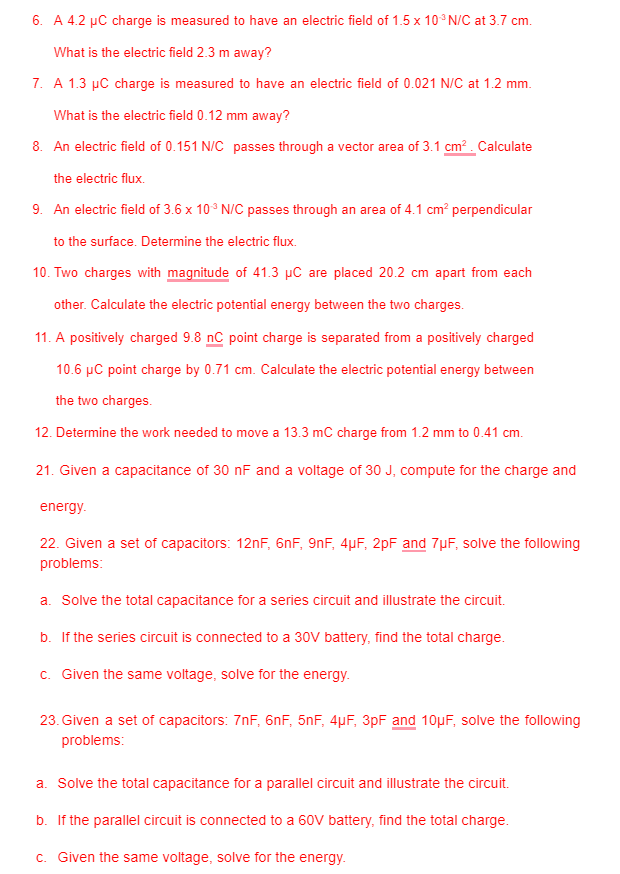11. A positively charged 9.8 nC point charge is separated from a positively charged 10.6 µC point charge by 0.71 cm. Calculate the electric potential energy between the two charges.
11. A positively charged 9.8 nC point charge is separated from a positively charged 10.6 µC point charge by 0.71 cm. Calculate the electric potential energy between the two charges.
Electricity for Refrigeration, Heating, and Air Conditioning (MindTap Course List)
10th Edition
ISBN:9781337399128
Author:Russell E. Smith
Publisher:Russell E. Smith
Chapter2: Basic Electricity
Section: Chapter Questions
Problem 20RQ: What is a proton? Where does it normally exist in an atom, and what is its charge?
Related questions
Question
CR1: ANSWER 11

Transcribed Image Text:6. A 4.2 µC charge is measured to have an electric field of 1.5 x 10° N/C at 3.7 cm.
What is the electric field 2.3 m away?
7. A 1.3 µC charge is measured to have an electric field of 0.021 N/C at 1.2 mm.
What is the electric field 0.12 mm away?
8. An electric field of 0.151 N/C passes through a vector area of 3.1 cm? . Calculate
the electric flux.
9. An electric field of 3.6 x 10° N/C passes through an area of 4.1 cm? perpendicular
to the surface. Determine the electric flux.
10. Two charges with magnitude of 41.3 µC are placed 20.2 cm apart from each
other. Calculate the electric potential energy between the two charges.
11. A positively charged 9.8 nC point charge is separated from a positively charged
10.6 µC point charge by 0.71 cm. Calculate the electric potential energy between
the two charges.
12. Determine the work needed to move a 13.3 mC charge from 1.2 mm to 0.41 cm.
21. Given a capacitance of 30 nF and a voltage of 30 J, compute for the charge and
energy.
22. Given a set of capacitors: 12nF, 6nF, 9nF, 4µF, 2pF and 7µF, solve the following
problems:
a. Solve the total capacitance for a series circuit and illustrate the circuit.
b. If the series circuit is connected to a 30V battery, find the total charge.
c. Given the same voltage, solve for the energy.
23. Given a set of capacitors: 7nF, 6nF, 5nF, 4µF, 3pF and 10µF, solve the following
problems:
a. Solve the total capacitance for a parallel circuit and illustrate the circuit.
b. If the parallel circuit is connected to a 60V battery, find the total charge.
c. Given the same voltage, solve for the energy.
Expert Solution
This question has been solved!
Explore an expertly crafted, step-by-step solution for a thorough understanding of key concepts.
Step by step
Solved in 2 steps with 2 images

Knowledge Booster
Learn more about
Need a deep-dive on the concept behind this application? Look no further. Learn more about this topic, electrical-engineering and related others by exploring similar questions and additional content below.Recommended textbooks for you

Electricity for Refrigeration, Heating, and Air C…
Mechanical Engineering
ISBN:
9781337399128
Author:
Russell E. Smith
Publisher:
Cengage Learning

Electricity for Refrigeration, Heating, and Air C…
Mechanical Engineering
ISBN:
9781337399128
Author:
Russell E. Smith
Publisher:
Cengage Learning